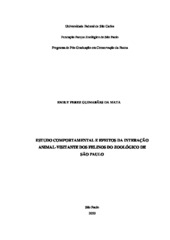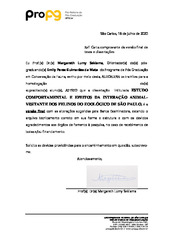Mostrar el registro sencillo del ítem
Estudo comportamental e efeitos da interação animal-visitante dos felinos do Zoológico de São Paulo
| dc.contributor.author | Mata, Emily Perez Guimarães da | |
| dc.date.accessioned | 2020-07-20T10:25:30Z | |
| dc.date.available | 2020-07-20T10:25:30Z | |
| dc.date.issued | 2020-05-20 | |
| dc.identifier.citation | MATA, Emily Perez Guimarães da. Estudo comportamental e efeitos da interação animal-visitante dos felinos do Zoológico de São Paulo. 2020. Dissertação (Mestrado em Conservação da Fauna) – Universidade Federal de São Carlos, São Carlos, 2020. Disponível em: https://repositorio.ufscar.br/handle/ufscar/13056. | * |
| dc.identifier.uri | https://repositorio.ufscar.br/handle/ufscar/13056 | |
| dc.description.abstract | Zoos play the role of conservation, research, environmental education, and recreation centers, and one of their main concerns is the welfare of the animals on display, which can be influenced by factors such as adequate enclosure, balanced feeding, veterinary management and interaction with visiting public. The presence of visitors may influence animal behavior, either positively or negatively. Thus, understanding animal-visitor interaction is extremely helpful in the quest to improve the animals’ well-being and raise public interest, because it may help the species' conservation. Therefore, the general objective of this work was to analyze the crowd’s effect on the behavior of the cats at the São Paulo Zoo, and how the behavior of the cats affects the public's interest. 20 hours of behavioral observations were made for each species - Herpailurus yagouaroundi, Puma concolor, Panthera onca, Panthera leo, and Panthera tigris tigris - via focal animal sampling for enclosures with only one individual and scan sampling for enclosures with multiple animals. The recorded behaviors were then correlated to the visitors' behavior, age group, and length of stay in front of the venues. Furthermore, modifications were made to the structural and environmental elements of the H. yagouaroundi enclosure to verify the effect of these changes on the activity of the animals and the perception and interest of the public, and, following, new behavioral observations were made. The results showed that cats, in general, exhibited behaviors related to rest, such as lying down or remaining inactive in structures. The stereotyped behavior, pacing, was observed more frequently for the jaguar. As for other factors that could influence the cat’s behavior, such as the age range of the visitors and the time of the visit, they showed no effect, however, the pacing events occurred mainly during mornings. After the changes were made in the H. yagouaroundi enclosure, there was a reduction in the inactive and stereotyped behaviors of the species. Therefore, the enrichment of ex situ environments can be considered an important tool for zoos and institutions with animals under human care to promote the welfare of the animals, providing more complex environments so their behavioral repertoire can approach what is observed in their natural habitat. Also, the setting of the enclosures may promote greater attractiveness to the visiting public and consequently deeper knowledge, affection, and respect for the animals in captivity. | eng |
| dc.description.sponsorship | Outra | por |
| dc.language.iso | por | por |
| dc.publisher | Universidade Federal de São Carlos | por |
| dc.rights | Attribution-NonCommercial-NoDerivs 3.0 Brazil | * |
| dc.rights.uri | http://creativecommons.org/licenses/by-nc-nd/3.0/br/ | * |
| dc.subject | Felinos | por |
| dc.subject | Comportamento animal | por |
| dc.subject | Percepção do visitante | por |
| dc.subject | Zoológico | por |
| dc.subject | Bem-estar animal | por |
| dc.subject | Felines | eng |
| dc.subject | Animal behavior | eng |
| dc.subject | Visitor perception | eng |
| dc.subject | Zoo | eng |
| dc.subject | Animal welfare | eng |
| dc.title | Estudo comportamental e efeitos da interação animal-visitante dos felinos do Zoológico de São Paulo | por |
| dc.title.alternative | Behavioral study and effects of animal-visitor interaction of felines at the São Paulo Zoo | eng |
| dc.type | Dissertação | por |
| dc.contributor.advisor1 | Sekiama, Margareth Lumy | |
| dc.contributor.advisor1Lattes | http://lattes.cnpq.br/7506297262479134 | por |
| dc.description.resumo | Os zoológicos atualmente desempenham o papel de centros de conservação, pesquisa, educação ambiental e lazer, e uma de suas principais preocupações é o bem-estar dos animais em exposição, que pode ser influenciado por fatores como recinto adequado, alimentação equilibrada, manejo veterinário e interação com o público visitante. A presença do visitante pode influenciar no comportamento dos animais, servindo tanto como um estímulo positivo quanto negativo. Portanto, compreender a interação animal-visitante é de extrema importância na busca por melhorar o bem-estar animal e por despertar o interesse dos visitantes, que pode contribuir com a conservação das espécies. Desta forma, o objetivo geral deste trabalho foi analisar a interferência do público no comportamento dos felinos do plantel do Zoológico de São Paulo e como o comportamento dos felinos impacta no interesse do público. Foram realizadas 20 horas de observações comportamentais para cada espécie: Herpailurus yagouaroundi, Puma concolor, Panthera onca, Panthera leo e Panthera tigris tigris, através da amostragem animal focal para recintos com apenas um indivíduo e Scan sampling para recintos com vários indivíduos, com registro instantâneo em intervalo de tempo. Os comportamentos registrados foram relacionados com o comportamento dos visitantes, faixa etária e o tempo de permanência em frente aos recintos. Além disso, foram feitas modificações dos elementos estruturais e ambientais do recinto do gato-mourisco para verificar o efeito dessas alterações no comportamento dos animais e na percepção e interesse do público, e em seguida, foram feitas novas observações comportamentais. Os resultados mostraram que os felinos, de maneira geral, exibiram comportamentos relacionados ao descanso, como deitar ou permanecer inativos nas estruturas. O comportamento estereotipado, pacing, foi observado com maior frequência para a onça-pintada. Quanto a outros fatores que poderiam ter influência no comportamento dos felinos, como a faixa etária dos visitantes e o período do dia, estes não estiveram relacionados aos comportamentos, no entanto, os eventos de pacing ocorreram, principalmente, no período da manhã. Após a ambientação no recinto do gato-mourisco houve uma redução nos comportamentos inativos e estereotipados da espécie. Portanto, o enriquecimento de ambientes ex situ pode ser considerada uma importante ferramenta para os zoológicos e instituições com animais sob cuidados humanos contribuírem para o bem-estar animal, proporcionando ambientes mais complexos para que o repertório comportamental da espécie possa se aproximar daquilo que é observado em vida livre. Além disso, a ambientação dos recintos pode promover maior atratividade aos visitantes, tendo como consequência maior conhecimento, afetividade e respeito pelos animais em situação de cativeiro. | por |
| dc.publisher.initials | UFSCar | por |
| dc.publisher.program | Programa de Pós-Graduação em Conservação da Fauna - PPGCFau | por |
| dc.subject.cnpq | CIENCIAS BIOLOGICAS::ZOOLOGIA::ZOOLOGIA APLICADA::CONSERVACAO DAS ESPECIES ANIMAIS | por |
| dc.subject.cnpq | CIENCIAS BIOLOGICAS::ZOOLOGIA::COMPORTAMENTO ANIMAL | por |
| dc.publisher.address | Câmpus São Carlos | por |
| dc.contributor.authorlattes | http://lattes.cnpq.br/9339760342899503 | por |


